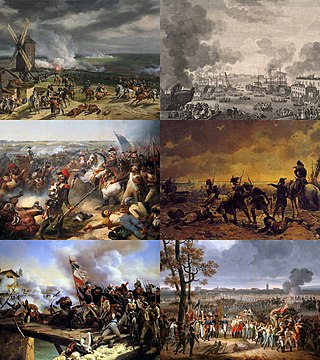
The War of the First Coalition was a set of wars that several European powers fought between 1792 and 1797, initially against the constitutional Kingdom of France and then the French Republic that succeeded it. They were only loosely allied and fought without much apparent coordination or agreement; each power had its eye on a different part of France it wanted to appropriate after a French defeat, which never occurred.
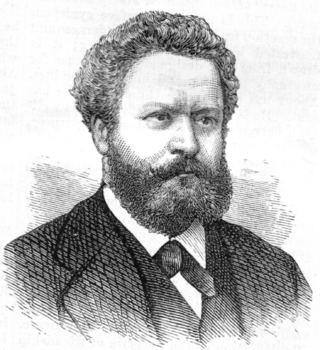
Edmond François Valentin About was a French novelist, publicist and journalist.
An outlaw, in its original and legal meaning, is a person declared as outside the protection of the law. In pre-modern societies, all legal protection was withdrawn from the criminal, so anyone was legally empowered to persecute or kill them. Outlawry was thus one of the harshest penalties in the legal system. In early Germanic law, the death penalty is conspicuously absent, and outlawing is the most extreme punishment, presumably amounting to a death sentence in practice. The concept is known from Roman law, as the status of homo sacer, and persisted throughout the Middle Ages.

A highwayman was a robber who stole from travellers. This type of thief usually travelled and robbed by horse as compared to a footpad who travelled and robbed on foot; mounted highwaymen were widely considered to be socially superior to footpads. Such criminals operated until the mid- or late 19th century. Highwaywomen, such as Katherine Ferrers, were said to also exist, often dressing as men, especially in fiction.

Klephts were highwaymen turned self-appointed armatoloi, anti-Ottoman insurgents, and warlike mountain-folk who lived in the countryside when Greece was a part of the Ottoman Empire. They were the descendants of Greeks who retreated into the mountains during the 15th century in order to avoid Ottoman rule. Klepht bands also included many ethnic Albanians. They carried on a continuous war against Ottoman rule and remained active as brigands until the 19th century.
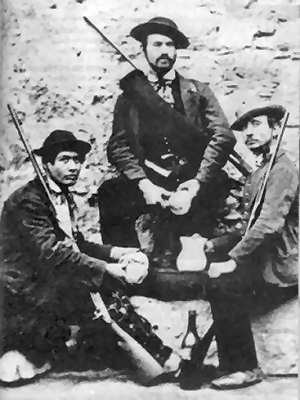
Banditry is a type of organized crime committed by outlaws typically involving the threat or use of violence. A person who engages in banditry is known as a bandit and primarily commits crimes such as extortion, robbery, and murder, either as an individual or in groups. Banditry is a vague concept of criminality and in modern usage can be synonymous for gangsterism, brigandage, marauding, terrorism, piracy and thievery.

The armatoles, or armatole in singular, were irregular soldiers, or militia, commissioned by the Ottomans to enforce the sultan's authority within an administrative district called an armatoliki. In Greek regions of the Ottoman Empire, they were composed of Greeks who were either former klephts or village stalwarts who had taken up arms against the klephts in the defense of their district.
Shifta is an term East African meaning rebel, outlaw, bandit, vigilante, brigand, or patriot. Originally having a heroic or anti-heroic connotation rather than a villainous character, over time, the term has taken on a more villainous meaning. It is a term mostly used in Ethiopia, Eritrea, Kenya, Tanzania, and Somalia. The Swahili word was loaned from the Somali shufta during the Shifta War, and is in turn derived from Amharic ሽፍታ (šəfta). Historically, the shifta served as a local militia in particularly remote, rural and often lawless parts of the Horn of Africa, namely the Ethiopian Highlands. The word shifta can be translated as "bandit" or "outlaw", but can include anyone who rebels against an authority or an institution that is seen as illegitimate, like the Arbegnoch guerillas during the Italian occupation of Ethiopia.
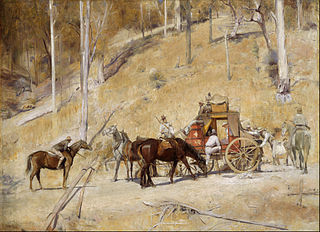
Social banditry or social crime is a form of social resistance involving behavior that by law is illegal but is supported by wider "oppressed" society as moral and acceptable. The term "social bandit" was invented by the Marxist historian Eric Hobsbawm and introduced in his books Primitive Rebels (1959) and Bandits (1969). Hobsbawm characterized social banditry as a primitive form of class struggle and resistance in pre-industrial and frontier societies. Social banditry is a widespread phenomenon that has occurred in many societies throughout recorded history, and forms of social banditry still exist, as evidenced by piracy and organized crime syndicates. Later, social scientists have also discussed the term's applicability to more modern forms of crime, like street gangs and the economy associated with the trade in illegal drugs.

Brigandage in Southern Italy had existed in some form since ancient times. However its origins as outlaws targeting random travellers would evolve vastly later on in the form of the political resistance movement. During the time of the Napoleonic conquest of the Kingdom of Naples, the first signs of political resistance brigandage came to public light, as the Bourbon loyalists of the country refused to accept the new Bonapartist rulers and actively fought against them until the Bourbon monarchy had been reinstated. Some claim that the word brigandage is a euphemism for what was in fact a civil war.

Carmine Crocco, known as Donatello or sometimes Donatelli, was an Italian brigand. Initially a soldier for the Bourbons, he later fought in the service of Giuseppe Garibaldi.
Francesco Paolo Varsallona or Varsalona was a Sicilian bandit who operated on the island around the turn of the 20th century. He is considered to be the last great bandit of the pre-fascist era. He hailed from Castronovo and was the son of a bandit that had belonged to the notorious band of Angelo Pugliese, better known as "Don Peppino il Lombardo", credited with introducing kidnapping people for money in Sicily.

Giuseppe Gaetano Maria Govone was an Italian general and politician of Piedmontese origin, who played a major role in the Italian Risorgimento.

The Fall of Constantinople in 1453 and the subsequent fall of the successor states of the Eastern Roman Empire marked the end of Byzantine sovereignty. Since then, the Ottoman Empire ruled the Balkans and Anatolia, although there were some exceptions: the Ionian Islands were under Venetian rule, and Ottoman authority was challenged in mountainous areas, such as Agrafa, Sfakia, Souli, Himara and the Mani Peninsula. Orthodox Christians were granted some political rights under Ottoman rule, but they were considered inferior subjects. The majority of Greeks were called rayas by the Turks, a name that referred to the large mass of subjects in the Ottoman ruling class. Meanwhile, Greek intellectuals and humanists who had migrated west before or during the Ottoman invasions began to compose orations and treatises calling for the liberation of their homeland. In 1463, Demetrius Chalcondyles called on Venice and “all of the Latins” to aid the Greeks against the Ottomans, he composed orations and treatises calling for the liberation of Greece from what he called “the abominable, monstrous, and impious barbarian Turks.” In the 17th century, Greek scholar Leonardos Philaras spent much of his career in persuading Western European intellectuals to support Greek independence. However, Greece was to remain under Ottoman rule for several more centuries. In the 18th and 19th century, as revolutionary nationalism grew across Europe—including the Balkans —the Ottoman Empire's power declined and Greek nationalism began to assert itself, with the Greek cause beginning to draw support not only from the large Greek merchant diaspora in both Western Europe and Russia but also from Western European Philhellenes. This Greek movement for independence, was not only the first movement of national character in Eastern Europe, but also the first one in a non-Christian environment, like the Ottoman Empire.

Li chiamarono... briganti! is a 1999 Italian film, directed by Pasquale Squitieri. It tells the story of Carmine Crocco, a 19th-century Italian brigand who gained recognition when he came to the forefront of the brigandage during the Italian unification, by opposing the army of King Victor Emmanuel II. It stars Enrico Lo Verso, Claudia Cardinale, Franco Nero, Remo Girone, Giorgio Albertazzi, among others. The movie was quickly suspended from its cinema run and it is not available on VHS or DVD. Some people think this was for the censorship of the Italian army.
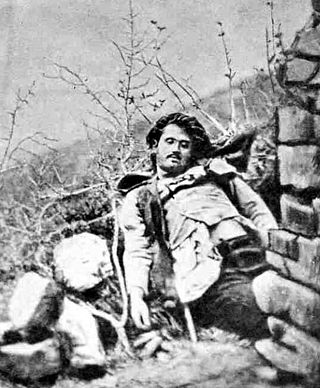
Giuseppe Nicola Summa, known as Ninco Nanco, was an Italian brigand. One of the most important brigands after the Italian unification, he was a lieutenant of Carmine Crocco, band chief of the Vulture area, in Basilicata. He was known for his brilliant guerrilla warfare and for his brutality against his enemies.
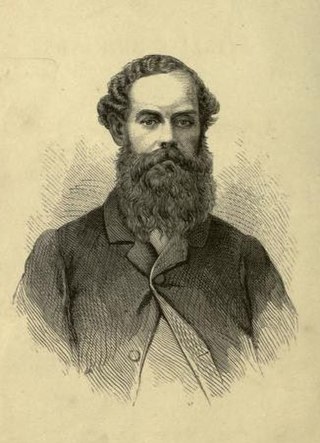
William John Charles Möens (1833–1904) was an English writer, known as an antiquarian dealing with Huguenot topics.
Sardinian banditry is a term which describes an outlaw behavior typical of the Mediterranean island of Sardinia, dating back to the Roman Empire. Twentieth-century Sardinian banditry had economic and political overtones.

Italian Brigands Surprised by Papal Troops is an 1831 painting produced in Rome by Horace Vernet. It is kept at the Walters Art Museum, Baltimore.
Christos Davelis was an infamous Greek brigand of Arvanite-Vlach descent, operating in the regions of Attica and Boeotia.



















